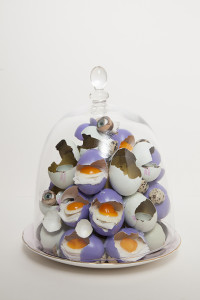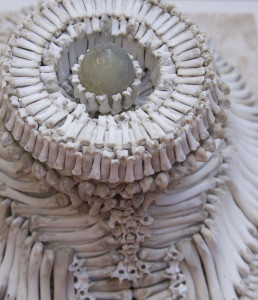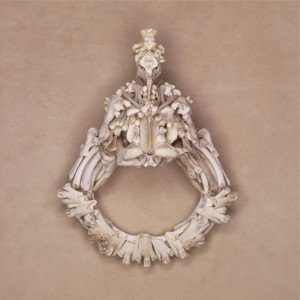* Traduzione italiana in calce.
They met on the Performance Design and Practice course at the Central Saint Martins, in London, in 2009, and have not looked back ever since. Emily Bridge and Emma Witter take the challenge of representing western food culture in extravagant sculptures and they confront people with the use of materials that will destroy your preconceptions about food by-products. Beast & Burden is an ongoing collaboration of dark humour and the modern dynamics of food perception. La Balena Bianca interviewed the artistic duo to find out more.
We know you met at the PDP Course at CSM, tell us more about your first collaboration for your graduate piece ‘FEAST’.
We created ‘FEAST’ as a live external project in our final year at Central Saint Martins. We responded positively to the freedom and challenge of working independently. We were fortunate to have some great young actors who were willing to give us their time as well as an amazing location: an old dining room above Bethnal Green library – a former 19th century mental hospital.
We came across food as a starting point after experiencing an argument in a restaurant. It made us think about how the seating arrangement could be used for a performance and how food is such a universal subject. After researching further we became interested particularly in the darker sides of food, like gluttony and fetish.
Our 10 audience members, after hand feeding a voluptuous woman, were seated along one side of a long dining table and tied together with a giant table cloth. They then witnessed 5 scenes, or ‘courses’ including choreography with pigs heads and mock-coprophilia. It was pretty out there!
What made you choose each other for ‘FEAST’?
The partnership just came very naturally for the project as we were already good friends and room mates. We have a similar sense of humour and knew that we would have a good time and let each other be free to experiment.
Why Beast & Burden? And when did you decide that you were going to become ‘pretty pretty pretty girls’ together?
It was around a year after we graduated, having worked independently on freelance projects, that we decided that we wanted to get back together and create a continuation of ‘FEAST’. We were putting together applications for funding and were sat in a pub pondering what our name would be if we started to set up a business together. ‘Beast of Burden’ [Rolling Stones] came on the speaker and we laughed, calling each other a ‘Beast’ and a ‘Burden’…but then it stuck. We like the alliteration and the darkness, and the idea that starting out trying to earn a living as an artist can be very much like pulling a heavy load up a steep hill.
In your statement, on your website, you say that you “connect on [your] shared interest in how social relationships and visual associations are triggered by food”; what are the visual associations food triggers when you look at it in order for you to develop the idea of a new art piece?
At first we were interested in how we unconsciously read people by how and what they choose to eat. We like the humour in this and started making little tests, creating and recording imaginary meals to represent characters. The way that a certain type of person might plate up, the foods they would choose or steer away from, their mannerisms when they eat.
We regularly return to a mix of humour and darkness in our visuals and enjoy taking everyday ingredients and objects and pushing them through their presentation to tell a story or create a feeling.
Your two series of ‘Egg’ and ‘Egg Vessels’ are a fascinating combination of bones, egg shells, feathers and porcelain. What was the message you wanted to come across in the creation of these pieces?
‘Egg’ was an exploration into the many different messages we give off through food. We were inspired by the story about the time when Gertrude Stein’s cook served Henri Matisse fried eggs instead of an omelette, revealing her disapproval of the painter. “It takes the same amount of eggs and the same amount of butter,” she said, “but it shows less respect, and he will understand.” We wanted to explore the different types of imagery and messages we could create all inspired by one most simple food, an egg.
‘Egg Vessels’ was a sort of continuation of this idea except we wanted to focus on juxtaposing the simplicity of an egg to the extravagant ways that we could present it. We also wanted to confront people with the repetitive use of bones to show that they are perfectly natural, as common and everyday as the feathers of the bird or the egg shells. Many in western culture are becoming more disconnected with what they are eating and where their food comes from.
Your work comprises set design and sculpture and you have collaborated with and produced artwork for many relevant clients in both the design industry and the food one. Which was the most challenging collaboration and which the most enjoyable and professionally satisfying?
We did some specialist prop making for a Rowntrees commercial in which we created a pastel fruit tower which had to collapse at a regular speed and towards the camera when a certain sweet was pulled out from it – like a complex sugary jenga. It was a major challenge for us working with movement for the first time using food! But was also really satisfying to get right.
Where do you take your inspiration from in the artistic world and the artists that have used such unusual materials before you?
We take inspiration from all over the place, we’re really into artists that explore nature and biology, or unusual materials and processes. We love the painter Jonny Green, we love Lorenzo Vitturi for his cross disciplinary practice, we love the personal works of photographer Peter Lippmann. We love Michael Dean’s sculptural works, and Julie Verhoeven for her free spirited installations and films. We are inspired by budding fashion designers like Biyuan Zhang and Olivia Creber who are making wild and beautiful objects and artefacts.
We spend a lot of time at galleries, graduate shows and screenings. We enjoy experiencing art and design just as much as creating.
You say you “want to help lose the macabre associations we have with bone and the disgust element of food waste”; do you think some of your pieces run the risk of increasing such associations people might have with bones and food waste?
Well, no one has been on the fence about our bone sculptures! And there definitely is a risk of making people feel uncomfortable by being presented with a material that they associate with death or decay.
It’s become a very interesting challenge to us to see if we can use this material in a way that is much softer, lighter and organic in feel and make people reconsider their preconceptions about it as a working material. Shells are equally the remains of animals bodies and a food by-product, but people tend not to have the same disconnection with them. We think about how we can create work to encourage people to perceive bones in the same way.
What are the next projects in line and where and when will we be able to see them?
We are working on a photo book which is a major continuation of our ‘Egg’ series, and hope to be launching this in the next year or two. For now we will be featuring various other works in upcoming exhibitions so keep track of our Facebook page and Twitter for updates and invites!
Italian translation*
Si sono conosciute al Corso di Performance Design and Practice all’Università Central Saint Martins a Londra, nel 2009, e da allora non si sono più voltate indietro. Emily Bridge e Emma Witter accettano la sfida di rappresentare la cultura gastronomica occidentale con sculture stravaganti e sconvolgono il pubblico con l’uso di materiali che distruggeranno i vostri preconcetti sui sottoprodotti alimentari. Beast&Burden è una continua fusione di dark humour e dinamiche moderne della percezione del cibo. La Balena Bianca ha intervistato il duo artistico per scoprirne di più.
Sappiamo che vi siete conosciute al Corso PDP alla CSM, raccontateci della vostra prima collaborazione per il progetto di laurea, ‘FEAST’.
Abbiamo creato ‘FEAST’ come un progetto esterno dal vivo, durante il nostro ultimo anno alla Central Saint Martins. Abbiamo risposto positivamente alla sfida di lavorare con libertà e indipendenza. Siamo state fortunate ad avere a disposizione dei fantastici giovani attori che erano disposti a darci il loro tempo e ad aver trovato una location straordinaria; una vecchia sala da pranzo collocata al piano superiore della biblioteca di Bethnal Green – un ex ospedale psichiatrico del 19esimo secolo.
Abbiamo scoperto il cibo come punto di partenza dopo una discussione al ristorante che ci ha fatto pensare a come la disposizione dei posti a sedere a tavola potesse essere usata in una performance artistica e a come il cibo fosse un soggetto universale. A seguito di un’ulteriore ricerca ci siamo interessate particolarmente ai lati oscuri del cibo, come l’ingordigia e il feticismo.
Il nostro pubblico di dieci persone, dopo aver sfamato una donna voluttuosa, è stato fatto accomodare lungo un solo lato di un grande tavolo da pranzo e legato con un tovagliolo gigante. A questo punto ha assistito alla presentazione di cinque scene, o ‘portate’, che includevano coreografie con teste di maiali e finta coprofilia… il tutto era piuttosto folle!
Cosa vi ha fatto scegliere l’un l’altra per ‘FEAST’?
La collaborazione è nata in modo molto naturale per il progetto, eravamo già buone amiche e conviventi. Abbiamo un senso dell’umorismo molto simile e sapevamo che ci saremmo divertite e che avremmo lasciato l’altra persona libera di sperimentare.
Perchè Beast&Burden e quando avete deciso che sareste state ‘pretty pretty pretty girls’ insieme?
Circa un anno dopo la laurea, trascorso lavorando indipendentemente a progetti freelance, abbiamo deciso che volevamo tornare insieme sulla scena artistica e creare un sequel di ‘FEAST’. Eravamo al pub cercando di compilare domande di bandi per ricevere fondi, pensando a quale potesse essere il nostro nome da artiste nel caso decidessimo di cominciare un’impresa insieme. Beast of Burden [dei Rolling Stones] cominciò a suonare dalle casse del pub e noi scoppiammo a ridere, iniziando a chiamarci a vicenda la ‘Bestia’ e il ‘Fardello’…ma poi ci è rimasto dentro. Il nome ci piace per l’allitterazione e l’”oscurità”, e per l’idea che provare a guadagnarsi da vivere come artista possa essere davvero come tirare un carico pesante su una collina ripida.
Nel resoconto del progetto, sul vostro sito web, scrivete di “condividere l’ interesse per come le relazioni sociali e le associazioni visive siano innescate dal cibo”; quali “associazioni visive” scatena il cibo quando lo osservate per sviluppare l’idea di un nuovo progetto artistico?
All’inizio eravamo interessate a come inconsciamente “leggiamo” le persone a seconda di come e cosa scelgono di mangiare. Ci piace l’umorismo che c’è in questo: abbiamo cominciato a fare dei piccoli test, creando e registrando cene immaginarie per rappresentare diversi personaggi. Il modo in cui una certa persona potrebbe disporre il cibo sul piatto, le pietanze che sceglierebbe e quelle da cui prenderebbe le distanze, le sue idiosincrasie durante il pasto.
Ci rifacciamo spesso a un insieme di umorismo e oscurità nelle nostre visioni e ci piace prendere ingredienti e oggetti quotidiani e spingerli a “presentarsi” al pubblico, raccontando una storia o susictando una sensazione.
Le vostre due serie ‘Egg’ e ‘Egg Vessels’ sono un’affascinante combinazione di ossa, gusci d’uova, piume e porcellana. Qual era il messaggio che volevate venisse fuori nella creazione di questi pezzi?
‘Egg’ era un’esplorazione dei tanti messaggi che mandiamo attraverso il cibo. Siamo state ispirate dalla storia della cuoca di Gertrude Stein, che, esprimendo la sua disapprovazione per Henri Matisse, servì al pittore uova fritte invece di un’omelette. “Serve lo stesso numero di uova e la stessa quantita’ di burro,” disse, “ma è molto meno di riguardo, e lui lo capirà’”. Volevamo esplorare diverse tipologie di immagini e messaggi si potevano creare traendo ispirazione da un ingrediente tra i più semplici, l’uovo.
‘Egg Vessels’ era una sorta di continuazione di questa idea, eccetto che stavolta volevamo concentrarci sul contrasto tra la semplicità dell’uovo e i modi stravaganti di presentarlo. Volevamo anche fare in modo che le persone avessero a che fare con l’uso ripetitivo di ossa, per dimostrare che sono perfettamente naturali, comuni e quotidiane così come le piume dell’uccello e i gusci delle uova. Molte persone, nella cultura occidentale, stanno diventando sempre più distaccate da quello che mangiano e da i luoghi da cui proviene il loro cibo.
Il vostro lavoro comprende scenografie e sculture e avete collaborato e prodotto opere d’arte per molti clienti importanti sia nell’industria del design che in quella della gastronomia. Qual è stato il lavoro più impegnativo e quale quello più divertente e soddisfacente da realizzare?
Abbiamo creato dei materiali di scena speciali per una pubblicità di Rowntrees: una torre di caramelle gommose alla frutta che sarebbe dovuta crollare ad una velocità regolare verso la telecamera quando una delle caramelle veniva tirata fuori dalla torre – come una complicata torre Jenga di zucchero. Lavorare per la prima volta con il movimento usando il cibo è stata un’impresa! Ma riuscirci è stata una vera soddisfazione!.
Dove prendete ispirazione nel mondo artistico? Guardate a degli artisti che hanno usato materiali insoliti prima di voi?
Prendiamo ispirazione dappertutto, siamo davvero interessate ad artisti che esplorano la natura e la biologia, o l’uso di materiali e procedimenti insoliti. Amiamo il pittore Jonny Green, amiamo Lorenzo Vitturi per la sua pratica interdisciplinare, amiamo il lavoro personale del fotografo Peter Lippmann. Amiamo le sculture di Michael Dean e pure Julie Verhoeven per i suoi film e per lo spirito libero delle sue istallazioni. Ci ispiriamo a designer di moda emergenti come Biyuan Zhang e Olivia Creber che stanno creando oggetti e artefatti bellissimi e folli.
Passiamo molto del nostro tempo presso gallerie d’arte, presentazioni di laurea e proiezioni. Ci piace conoscere l’arte e il design quanto ci piace crearli.
Voi dite che “volete aiutarci a superare le associazioni macabre legate alle ossa e a vincere il disgusto per i rifiuti alimentari”; pensate che alcuni dei vostri lavori possano correre il rischio di incrementare il senso di ripugnanza che le persone provano verso ossa e rifiuti?
Beh, nessuno è rimasto freddo davanti alle nostre sculture di ossa! E c’è sicuramente il rischio di far sentire il pubblico a disagio presentandogli materiali che generalmente vengono associati a morte e decadenza.
Per noi è diventato uno stimolo interessante vedere se è possibile usare le ossa in una maniera più delicata e leggera, rendendone naturale il contatto; un approccio che faccia riconsiderare i preconcetti sull’uso di questo materiale. Anche i gusci [o le conchiglie] sono resti di corpi animali e sottoprodotti alimentari, ma le persone non li tengono a distanza come fanno con le ossa. Pensiamo a come poter creare lavori che incoraggino le persone a percepire le ossa nello stesso modo.
Quali sono i prossimi progetti e dove e quando avremo la possibilità di vederli?
Stiamo preparando un libro fotografico che rappresenti un proseguimento importante della nostra serie ‘Egg’, e speriamo nella pubblicazione entro il prossimo anno o due. Inoltre abbiamo in cantiere altre opere che saranno visibili in prossime mostre, perciò rimanete aggiornati con le nostre pagine Facebook e Twitter per futuri inviti!
* Italian translation by Alessandra Scotto di Santolo and Lorenzo Cardilli.


